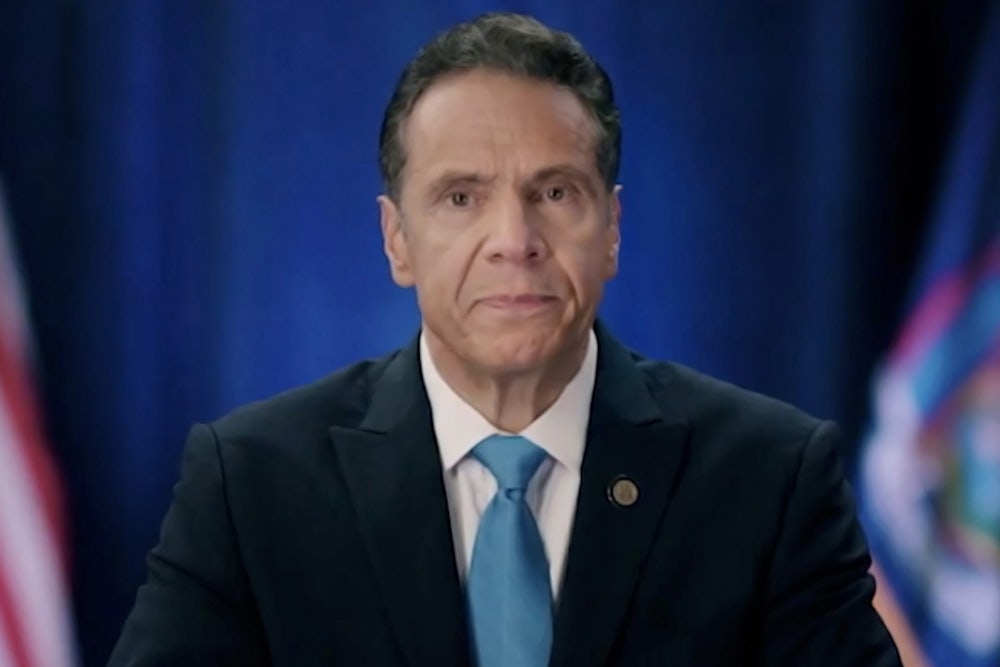Andrew Cuomo is hanging by a thread. He may hold onto his job for another day or another week, or even longer. But he is well past the political point of no return. Given what needs to be done just in the next two months alone—virtually the entire state of New York has to be reopened—there’s simply no conceivable way a figure as damaged as Cuomo is can do his job.
The writers of Cuomo’s political obituary may very well point to Friday morning as the moment it all came crashing down. Yes, the New York governor had been embattled for some time—first by revelations that his administration covered up nursing home deaths; then by a cascade of allegations of sexual harassment, misconduct, and other inappropriate behavior, with further reports of an office culture dominated by Cuomo’s megalomania and bullying. But Friday was a day of shoes dropping, one after another.
Over a dozen members of New York’s congressional delegation called for Cuomo’s resignation. Some, like Alexandria Ocasio-Cortez and Jamaal Bowman, represented the left wing of the Democratic Party, which has been the governor’s primary antagonist for some time. But the group also included moderates and longtime allies, including Jerry Nadler and Sean Patrick Maloney.
Shortly thereafter, every Long Island Democrat in the New York Senate—one of Cuomo’s most important bases of support for years—called for him to step aside. Then New York’s Rebecca Traister published a thorough and damning investigation into the governor’s toxic workplace culture, with even more examples of egregious behavior. Not long after that, The New York Times published a similar investigation that labeled his office “the worst place to be,” according to one former staffer, state Senator Alessandra Biaggi.
All of this happened in the course of about an hour.
Cuomo has been under siege for over a month, but the situation has changed drastically this week. There have been new allegations of inappropriate behavior dropping almost daily, and the calls to resign grow by the hour. The governor has been prepping to outlast an impeachment inquiry, working the phones in his customary manner to keep members of New York’s State Assembly from abandoning him. That effort has, thus far, largely been successful, but events have begun to outpace a possible impeachment.
Cuomo has remained defiant, saying in a Friday afternoon press conference that he won’t bow to “cancel culture.” Cuomo is not the resigning type. But it’s also not clear how he serves out his term, either.
Much can be gleaned from whom politicians compare themselves to. Not long ago, Cuomo’s model was FDR, a leader who exuded poise and empathy as he managed the Great Depression. Cuomo modeled his daily Covid-19 briefings on FDR’s fireside chats, a historical nod picked up by many in the media. At the same time, Cuomo was also compared—often favorably—to Joe Biden, with some calling for the New York governor to be selected as vice president or even replace Biden on the ticket.
Now the aides who have stuck with the governor keep returning to one name: Virginia Governor Ralph Northam. Northam became embroiled in scandal in early 2019, when it was revealed that he had worn blackface while in medical school. There was a torrent of calls for him to resign that was, in some ways, more serious than the one Cuomo is facing now: Both of Virginia’s senators called on Northam to step down, as did Kamala Harris, Elizabeth Warren, Pete Buttigieg, and Hillary Clinton. Northam did not resign, however, and will, barring another unforeseen scandal, serve out his term in office with a slate of accomplishments and a reasonably high approval level.
But Cuomo’s situation is far different from Northam’s. The Virginia governor remained in office in large part because his potential successors also became embroiled in scandals at the exact same time. Lieutenant Governor Justin Fairfax was accused of sexual assault. Attorney General Mark Herring admitted that he, too, had worn blackface. In contrast, Kathy Hochul, Cuomo’s lieutenant governor, is a milquetoast public servant who seems to be untainted by any of the scandals swirling around Cuomo at the moment.
While Northam faced calls to resign from the leaders of Virginia’s two legislative chambers, he was able to quickly repair those relationships, something that simply isn’t possible for Cuomo. While the State Assembly has largely remained more loyal than the Senate, which is more or less in open rebellion, Cuomo has spent a decade in office bullying, cajoling, and humiliating politicians sitting in these bodies. Part of what we’re seeing now is payback. Thanks in part to Cuomo’s decision to single-handedly prevent a Democratic majority from taking hold in the Senate for several years, there is an extraordinary amount of bad blood.
Cuomo’s emerging model for holding on amid a seemingly endless series of damaging revelations is Donald Trump, a figure he has more than a passing resemblance to. Like Trump, Cuomo is a bully who relishes projecting the image of a tough guy. Like Trump, he loves attacking the press and humiliating rivals. Now Cuomo has little choice but to run the Trump playbook: attacking the media, his accusers, and his rivals, while barreling ahead as if no scandal is happening. Unlike Trump, however, there are many people in his own party working to hold him to account.
Unfortunately for Cuomo, the last month has made it abundantly clear that his methods aren’t actually very effective. While Cuomo has built a reputation as a master of the dark arts, someone adept at twisting arms, the scandals he’s facing now show that Cuomo’s approach to politics has hampered success, rather than fostered it. This man is not competent, even when he isn’t bogged down by scandal.
This, ultimately, is Cuomo’s choice. He can become more Trumpian and reinvent himself as a cancel culture martyr. He may very well hold onto his job if he does this but not to power. Stepping aside, given what New York has to do in the next three months, is the most sensible option. Cuomo has nothing to offer now, and everyone knows it.








